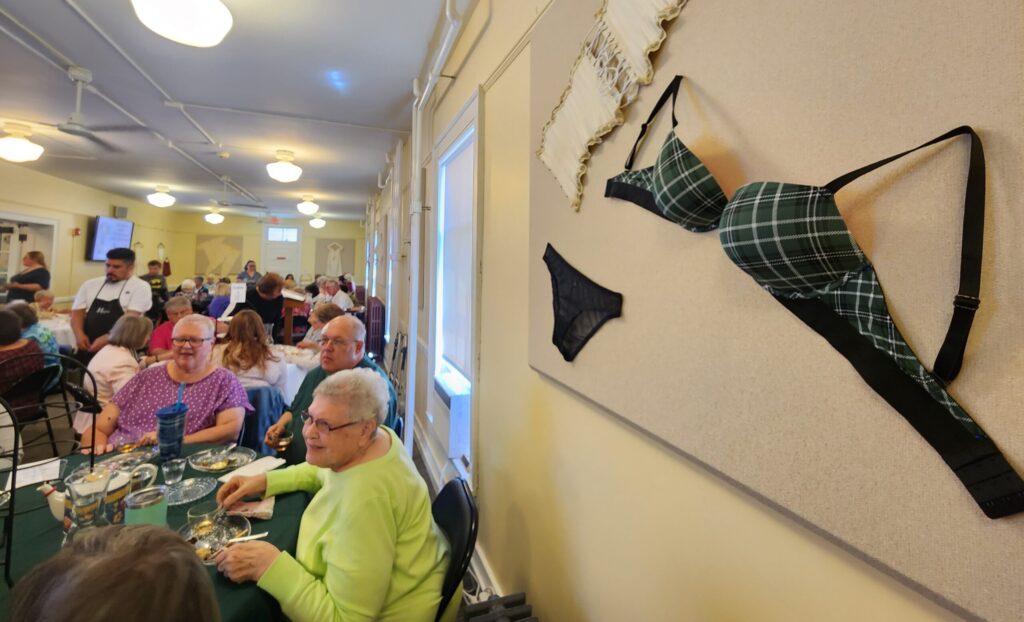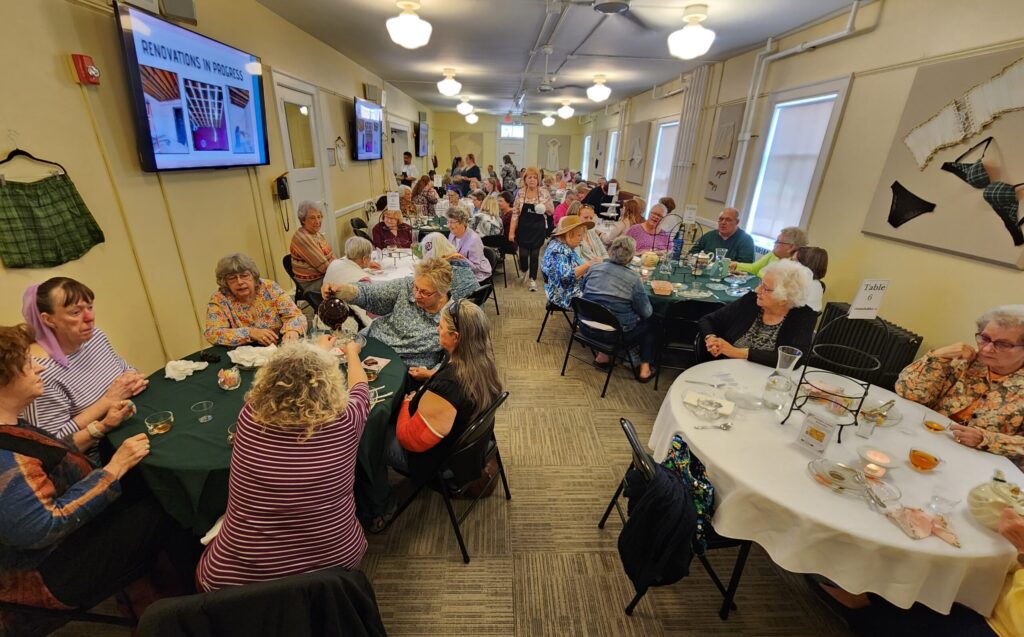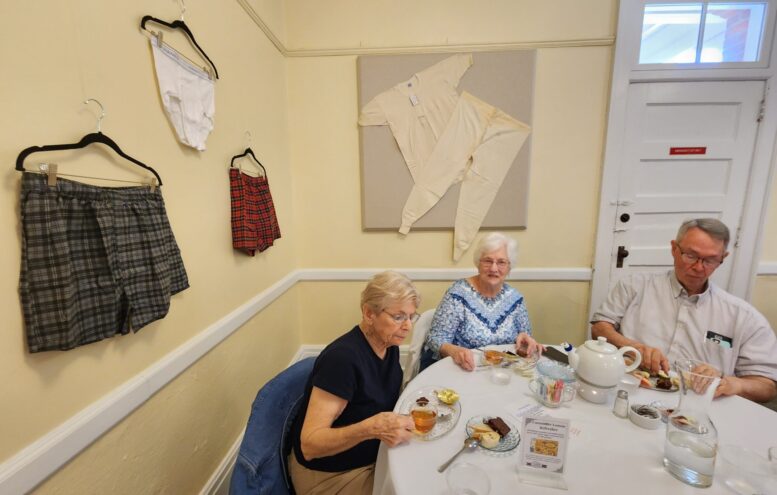By JAN LARSON McLAUGHLIN
BG Independent News
The underwear hanging from the walls provided the first clue that last week’s tea at the Wood County Museum was different from previous tea parties. The second clue – the number of men in attendance – was no doubt due to the program topic of “Underwear Etiquette.”
Alex Hutchings, assistant event coordinator at the museum, pulled back the curtain on Victoria’s secrets through the ages.
“I don’t know about you, but this is my first underwear tea party,” she said to the sold-out audience.
Hutchings mentioned all the unmentionables adorning the walls – the bloomers, boxers, briefs and bikini bottoms.
“More than one person offered me their underwear to put in the room,” she said. Her visual aids also included clips from movies showing the changes from the puritanical petticoats of “Gone with the Wind” to the bodice-ripping “Bridgerton.”
But there were limits to how revealing the program would be. “Sadly, there are no live models.”

Hutchings set the boundaries.
“Today we will be focused on the lower half of the body.” Corsets are for another day, said Hutchings, who said she once wore a corset for 110 days to research the effects on the body.
“This is truly my passion,” said Hutchings, a self-described feminist since fourth grade.
With the focus on below the waist undergarments, she warned her audience to prepare for possible uncomfortable verbal wedgies.
“You are about to hear the word ‘crotch’ multiple times,” she cautioned.
Hutchings asked her audience to travel back in their lifetimes to Sunday mornings of their childhoods. She asked how many were regular churchgoers – and hands shot. “We are definitely in the Midwest,” she said.
Back then, Sunday church meant parishioners dressing their parts. Men and women were expected to dress morally and “correctly” gendered. There was no “gray area” for women who would have gotten looks of disapproval for not wearing dresses or skirts to church.
As recently as the last 50 years ago, there were still expectations for outer – and under wear. Breaking the code of polite behavior in society meant being judged and shamed, she said.
Hutching’s presentation stretched back to caveman times, thanks to the 1991 unearthing of “Otzi” the iceman’s mummified remains from 5,200 years ago in the Italian Alps.
Among other fur items, the iceman was found wearing a loincloth made from goat leather – with the fur on the inside. Hutchings wondered if the loincloth was simply two rectangles in the front and back, but was advised that it was more like a diaper.
“This is the first piece of underwear in our history,” she said.

No real advancement of underwear was recorded until the mid 1700s, when men’s drawers became a trend for men who could afford them. Then in the 1850s to early 1900s, men’s underwear stretched from the waist to ankle, with straps at the feet.
In 1868, the “union suit” came into fashion, featuring a one-piece garment, with a flap at the buttocks. Famous boxer John Sullivan popularized “long johns” – a name shared by eclair bakery sticks.
In the 1920s, boxer shorts hit the shelves. “Aren’t these so adorable,” Hutchings said, showing an old advertisement selling the boxers – three for $1.
Then in 1935, the floppy boxers were wedged out by “tighty whities” briefs.
Women’s underwear arrived much later than men’s, but made great advancements over a relatively brief span of time. In the 1600s and 1700s, women’s undergarments might have included a slip or chemise – but still no underwear.
Women’s privates were much more, well, private. And a woman’s future could be ruined with something like an unchaperoned buggy ride, Hutchings said.
“A reputation was all a woman had,” she said. “A man could get away with a bad reputation. A woman could not.”
Hutchings told the story of Sarah Morgan, a well-bred lady who kept diaries covering her life during the Civil War era. On two occasions, Morgan was seriously injured in a carriage crash and horse riding accident. In one, her back was broken.
But her primary concern both times was the possibility that her feet or ankles might have been exposed to the male gender. That reveal was quite unnerving for ladies of that era, her diary described.
The time had not yet arrived when the site of a woman’s exposed ankle thrilled men and gave them cause to swoon – without permanently staining a woman’s reputation.
Gender boundaries still held strong, with men having the security of closed crotch underwear, but women having open crotch knickers. That of course limited women to riding sidesaddle.
Those revealing undergarments also made the high kicks of cancan performers particularly scandalous – and popular with men. “It was the hot ticket in town, just for men,” Hutchings said.

After centuries of women’s skivvies styles remaining stagnant, the 1920s brought about big changes – the right to vote and closed crotch undies. And by 1927, women’s skirt lengths had inched up the knees.
While women freed themselves of corsets, they became saddled with girdles and now Spanx.
Women’s underwear options are now vast, Hutchings said, especially when compared with men’s choices being basically limited to briefs or boxers.
“It’s all about function for you men,” she said. “For women it’s all about form.”
But both genders share interest in the underworld of underwear – as shown by the tea party attendance.
“There’s more men here today than there’s ever been,” said Gordon Bowman, a regular at the tea programs and a historical board member from Pemberville.

